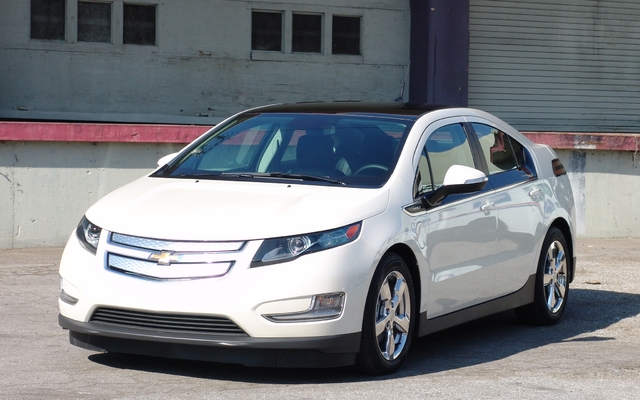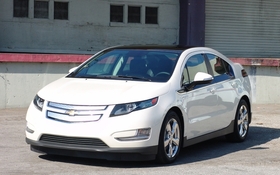2011 Chevrolet Volt: An Amercian dream becomes reality

| Strong points |
|
|---|---|
| Weak points |
|
Enough with the whispers and off-the-record remarks from engineers. We finally had the chance to drive a production-model 2011 Chevrolet Volt... well, almost. Let’s say that the version we tried is very close to what will soon be sold to American consumers. And, you guessed it, Canadians will have to wait until next spring!
The concept behind the 2011 Chevrolet Volt is so simple that it actually required a lot of thought. Since all-electric vehicles are still unable to offer enough range to suit most drivers, the GM engineers had the brilliant idea of pairing a gas engine with two electric motors. In this case, the gas engine does not power the front wheels. Instead, it acts a generator whose only function is to recharge the battery. For more information on its technical workings, read the article that my colleague Denis Duquet wrote about the 2011 Volt.
The beauty behind the Volt
To make a long story short, the Volt can cover 40 miles (65 km) on a single charge. That means that if you live 30 km from your work, you can do the round trip in all-electric mode. If, however, you have a longer distance to cover, the gas engine will kick in to provide electricity to the battery. A while ago, a hot debate was triggered when various websites claimed that the Volt’s gas engine powered the vehicle’s wheels. But one of the engineers (and a pretty one at that) in charge of the Volt project, and who accompanied us on our test drive, maintains that this is not the case. The confusion arises from the fact that when energy demands are very high, the power produced by the gas engine is immediately used by the electric engines instead of transiting through the battery. This is a basic way of summarizing a highly technical process, which I admit included some nuances that I didn’t totally understand...
During the Winter Olympic Games, the Car Guide team and I had the chance to get behind the wheel of a pre-pre-production Chevy Volt. Consequently, we were able to gauge how much the model has evolved since then. The body hasn’t changed much, but there have been a few tweaks here and there. Nothing major. Inside, however, there have been more improvements. First off, the trained eye will note that gear shifter is not as big as it once was. According the radiant engineer with us, the people who complained about the enormous protrusion were right. The various graphics on the two screens do not seem to have changed, but we didn’t explore them in depth, as we only had the car for a few minutes. In the previous version, musical notes chimed when the gas engine came on, but this is no longer the case. We’re willing to bet that most people won’t even notice when the thermal engine engages and starts recharging the battery.
Sport mode that ain’t no more
According to our lovely hostess, the changes made to the mechanics mostly affect the engine management programs. During our Vancouver test drive, there had been a "Sport" button on the dashboard that, once engaged, added 20 kW, which is like a boost of nitro. This function is no longer offered. Instead, there’s a "Drive Mode" button with three settings: Normal, Mountain and Sport. Instead of affecting the power released by the electric engine, the latter influences the accelerator pedal, making it more responsive. Nothing to write home about, I’m sure you would agree. We figure Mountain mode kicks in when fuel demands are higher, such as on hilly terrain. In this mode, the gas engine intervenes sooner as a means of ensuring that the battery keeps higher energy reserves, just in case the demand for power increases even more. Incidentally, the gas engine cannot completely recharge the battery. Its purpose is to maintain a minimum level of energy. To fully charge the lithium-ion battery, the car needs to be plugged in.
The 2011 Chevrolet Volt, with its big battery and gas engine, is one hulky vehicle weighing in at 1715 kg. This was enough to prompt Chevrolet to add disc brakes to the rear wheels. During our short city stint in this car, the gas engine was not called upon. However, we did note that the front face bar, whose size and shape were determined with aerodynamics in mind, was so low that it rubbed the asphalt as we went over a small curb. Wonder what that will be like in January...
Cold Ontario winters
When we brought up winter with our competent engineer guide, she assured us that several Volts have successfully covered countless kilometres of test drives in the hellishly cold area of Kapuskasing, in northern Ontario ( a region she didn’t seem to hold dear). So, it stands to reason that the production-model Volt should be able to withstand the worst of Canadian winters! Other intensive testing has taken place in the Mohave Desert. Buyers should know that heat is even harder on the batteries than cold. However, a complex battery heating and cooling system is included to regulate its temperature as needed.
The same Chevrolet engineer (married, unfortunately) informed us that although the gas engine could, in theory, never turn on, it should be activated at least once every two months. While it’s important to control emissions, you want to make sure the engine gets lubricated. Plus, if the engine never burns any fuel, it could degrade over time. And by the way, it takes super gas, which results in a lower rate of fuel consumption.
There are three ways to charge the Volt. First, as with all hybrid plug-ins, you can simply connect to a 120-V or 220-V outlet or to a charging station. Alternatively, you can hold off on charging it until the battery reaches an optimal temperature (hot when it’s cold out or cold when it’s hot out). To do this, you can pre-set the start time for the charge, and the system handles the rest. Finally, you can choose to charge when electricity rates drop. It’s up to the vehicle’s owner to enter the rates into the system.
With her, it’s serious…
Our test drive, for which we had exceptional company, allowed us to learn a lot more about this revolutionary vehicle’s road handling. The power seemed to be delivered more promptly than last winter’s trial (which felt more like summer, as each snowflake was welcomed with much fanfare at the Vancouver Olympics). The steering, however, may have lost some of its precision and feedback, even though it didn’t have that much to lose… A more exhaustive test drive is in order to give us a more complete idea!
GM is playing big with the Volt. This project has been on the burner for nearly four years (January 2007 Detroit Auto Show). GM management hasn’t stopped talking about it since. If the result doesn’t meet consumer expectations, the whole thing could have disastrous effects on GM’s image. But the more we try it, the more we’re inclined to say that, for once the General has done a great job! And he certainly hires some very interesting engineers…











